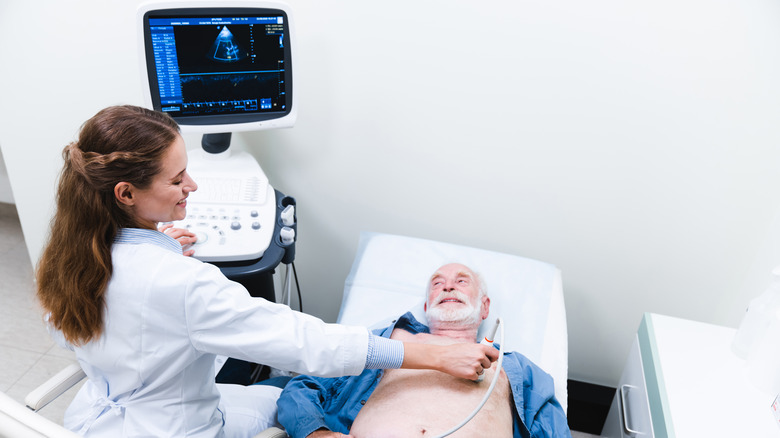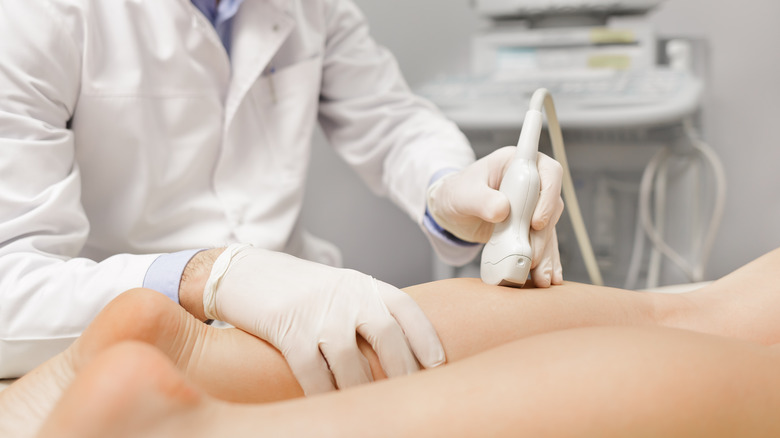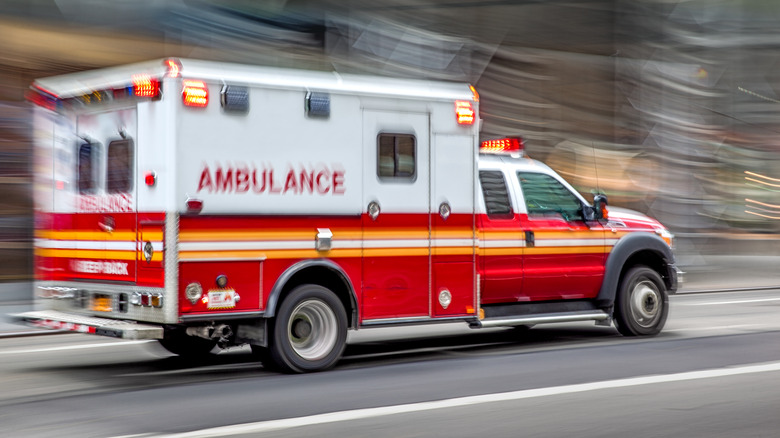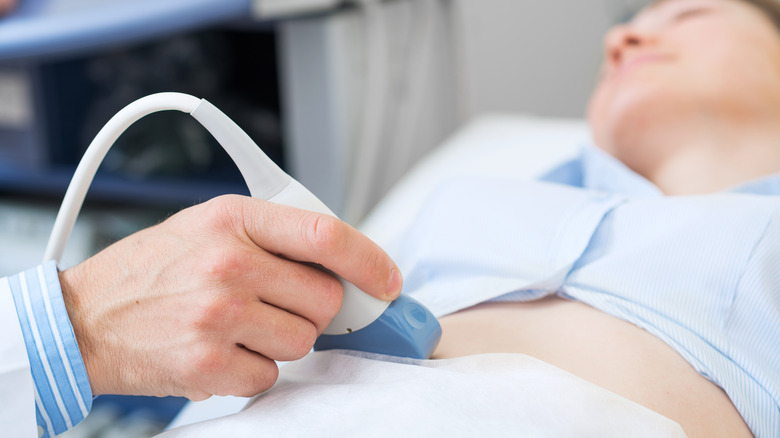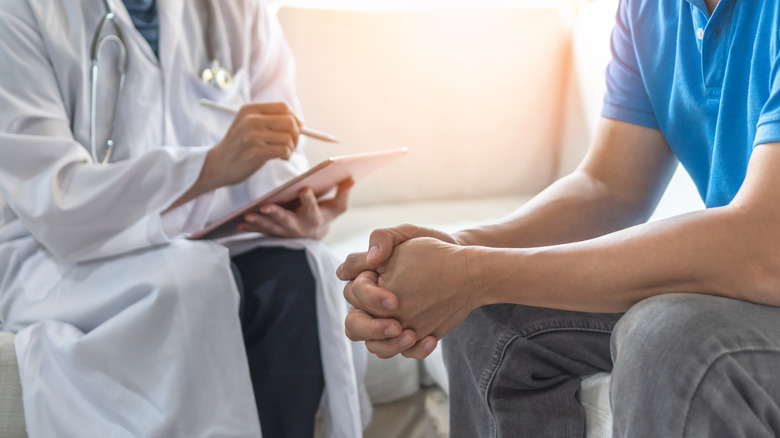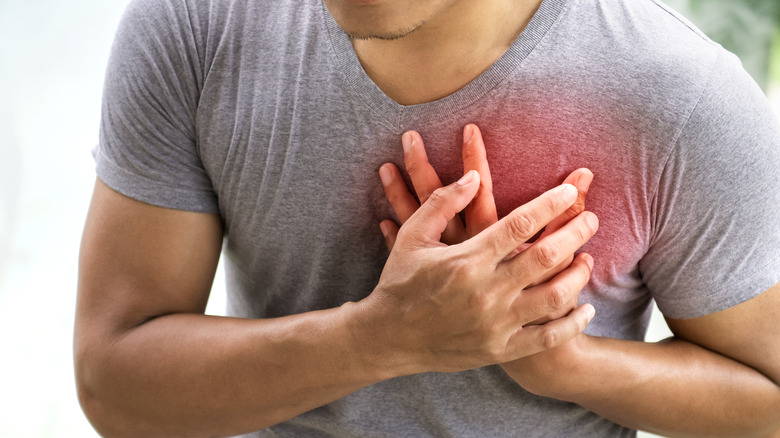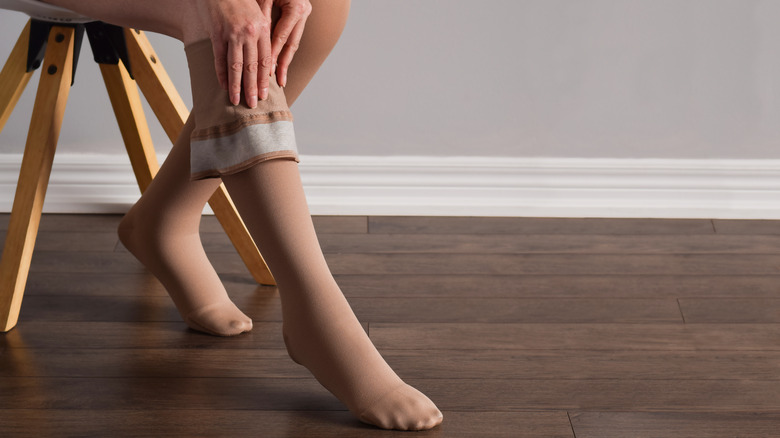Everything You Should Know About Blood Clots
How much do you know about blood clots? The term "blood clot" is commonly used to describe blood that has changed from a liquid to a gel-like or semisolid state (per Healthline). This can also be referred to as a thrombus. Although not always serious, blood clots can impede blood circulation, cause painful symptoms, impact a person's quality of life, and lead to dangerous health conditions. It is important to understand that blood clots don't only occur in the elderly or those with underlying health issues. Verywell Health shares that there are many potential risk factors involved, including genetics.
According to the Centers for Disease Control and Prevention, an estimated 900,000 people experience blood clots each year. Perhaps even more alarming, as many as 100,000 people die from them annually. Early diagnosis and treatment are crucial in order to prevent serious complications, including death. Below, we cover everything you should know about blood clots. If you have concerns about your circulatory health, we recommend talking to your doctor as soon as possible.
If you are experiencing blood clot symptoms like pain, swelling, cramping, redness, warm skin, shortness of breath, coughing, or fever, please seek immediate medical evaluation.
Blood clotting is not always a bad thing
There's little doubt that blood clots can be dangerous. But did you know that blood clotting (coagulation) is often beneficial? If blood did not clot, you could eventually bleed to death from even a minor scrape (via Harvard Health). In other words, blood clotting is an integral part of the body's normal healing process.
For a better understanding of how wounds heal, Johns Hopkins Medicine explains that mere seconds to minutes after a cut begins to bleed, "blood cells start to clump together and clot, protecting the wound and preventing further blood loss." Next, your blood vessels open up to bring in fresh oxygen, nutrients, and red blood cells to the site. These essential elements aid healing and help build new tissue. The rebuilding process leads to scabbing and new tissue strengthening, which usually takes around three months. During this time, you may experience some symptoms at the site, like "stretching, itching, and even puckering," according to Johns Hopkins. Depending on wound severity, the entire healing process could take months or even years. Chronic wounds, or wounds that take a long time to heal, sometimes occur when a wound doesn't receive enough oxygenated blood.
After an injury eventually heals, the body usually dissolves the involved blood clot naturally (per Hematology). Sometimes, blood clots can form within veins or arteries that are not due to injury. This type of blood clot is generally considered more serious and may require treatment.
Some blood clots are dangerous
Although clotting at the site of a wound is not usually cause for alarm, greater concern may be warranted for blood clots that develop within the veins and arteries. First of all, you should be aware that there are two main types of blood clots: superficial thrombophlebitis and deep vein thrombosis (DVT). Superficial thrombophlebitis describes a blood clot that forms in veins located close to the skin's surface (via Healthline). Symptoms can include redness, warmth, tenderness, pain, darkened skin, and hardening of the affected vessel. Most often, the legs are impacted, but superficial thrombophlebitis can also occur in the arms and neck.
According to WebMD, deep vein thrombosis (DVT) is a more serious type of blood clot that develops in the deep venous system. DVT requires immediate treatment, as it can lead to a life-threatening condition called pulmonary embolism. This occurs when a piece of the blood clot breaks off and travels to the lungs, leading to a partial or complete arterial blockage. DVT can develop in the thigh, lower leg, pelvis, or, sometimes, the arm (per CDC). While treatment is widely available, it is important to know your risks and understand that anyone, of any age or health status, can develop DVT.
You may be at risk for blood clots
While it's certainly true that anyone can develop a blood clot, the reality is that some individuals are more at risk. According to the American Heart Association, contributing factors include genetics, inactivity, obesity, smoking, pregnancy, and underlying health issues, including metabolic syndrome and diabetes. Although, unfortunately, you can't control all of these risk factors, you may be able to make lifestyle changes that reduce your blood clot risk along with benefitting your overall health.
To get started, the CDC recommends a number of measures to improve blood flow. When sitting for long periods of time, try to take a break to walk around every two to three hours and perform seated leg stretches. You can also help prevent blood clots by drinking plenty of water and eating certain foods (like garlic) and avoiding others (like red meat), according to Everyday Health. Additionally, Healthline recommends losing excess weight, quitting smoking, and getting more exercise.
Physical inactivity has been identified as a particular risk factor for pulmonary embolism among women, according to a research study published in the British Medical Journal (BMJ). Women wishing to avoid this life-threatening health condition (and who wouldn't?!) should look to stay active.
Blood clots can develop throughout the body
If you or someone you know has ever experienced a blood clot, odds are high that it occurred in a leg. However, Medline Plus explains that blood clots can develop throughout the body: in the leg, arm, abdomen, lungs, brain, and heart.
Blood clots occur in both veins and arteries. In case your education on the circulatory system occurred eons ago, here's a brief refresher: Arteries carry blood, oxygen, and nutrients from the heart to your muscles and organs. Veins, on the other hand, transport depleted blood back to the heart for reoxygenation (via WebMD).
Arteries function under higher pressure than veins. Because blood clots are more likely to occur in slower-moving blood, they tend to develop more often in veins than arteries. That said, when a clot does form in the arteries, it is more likely to break off and travel to other areas of the body, potentially resulting in a medical emergency (via Vascular Center of Wichita Falls).
Why are the legs most commonly affected?
We know that blood clots are most likely to develop in the legs, but why is this the case? A large piece of the puzzle is gravity. When leg veins transport blood back to your heart, they are working against gravity. According to MedicineNet, when you walk and move around, your leg muscles contract around the veins and squeeze blood back up towards the heart. On the other hand, your leg muscles relax during times of inactivity, causing blood circulation to slow and increasing your risk for blood clots. Health issues like obesity and smoking can strain and damage veins, further increasing this risk.
Of note, deep vein thrombosis (DVT) usually impacts only one leg (via Harvard Health). Dr. Scovell explained to the publication, saying, "When you get a blockage, the blood can't leave your leg easily. That leg can become swollen rather suddenly, and painful." If you experience sudden symptoms like pain, swelling, and redness in just one of your legs, this is a telltale sign to get medical help immediately.
Blood clots can cause a range of symptoms
Since blood clots can affect anyone at any age, everyone should be on the lookout for their warning signs (per WebMD). However, keep in mind that symptoms vary based on location within the body. An abdominal blood clot, for instance, may involve stomach pain, diarrhea, and vomiting.
According to WebMD, signs of a heart blood clot include excessive sweating, difficulty breathing, and chest pain. Common symptoms of a blood clot in the lung are shortness of breath, coughing, sweating, dizziness, and chest pain. And blood clots in the brain may involve vision changes, seizures, and weakness.
It is critical not to ignore blood clot symptoms, since complications can be dire. If you believe that you may have a blood clot, contact your doctor immediately or seek emergency medical care. Early detection is key. According to the CDC, "Early diagnosis is critical to prevent death."
They can place you at risk for dangerous health conditions, including more blood clots
Along with increasing your risk for heart attack, stroke, and pulmonary embolism, blood clots can lead to other dangerous and chronic health conditions. For one, deep vein thrombosis (DVT) can contribute to chronic venous insufficiency, which is a condition in which the leg veins are unable to efficiently transport blood back to the heart (via Johns Hopkins Medicine). This can lead to chronic leg pain and swelling, which may impact quality of life. It also causes varicose veins. Per a 2014 study published in the International Journal of Health Sciences, chronic venous insufficiency is a common health issue, affecting 25 to 40% of women and 10 to 20% of men.
According to Cedars Sinai, DVT can also lead to post-thrombotic syndrome. This chronic health condition can cause leg pain, swelling, itching, and skin discoloration. Early diagnosis and treatment of blood clots, along with the use of compression stockings, may help prevent post-thrombotic syndrome.
People with a history of blood clots are more likely to experience another one, according to the CDC. Approximately one-third of individuals diagnosed with DVT or pulmonary embolism will have a recurrence within 10 years.
Diagnostic tests are available
For many reasons, it is important to seek immediate medical evaluation if you experience blood clot symptoms. However, you may be wondering what to expect when you arrive at the doctor's office, urgent care, or emergency room.
To begin, your doctor will ask about your symptoms and perform a physical exam. When a blood clot is suspected, ultrasound imaging is usually ordered to confirm the diagnosis. Sometimes, a doctor will order a scan called CT angiography (CTA) to check for blood clots in the chest, abdomen, pelvis, or head (per Radiology Info). Alternatively, an MRI may be recommended to look at veins in the stomach (via Mayo Clinic).
Additionally, blood tests can demonstrate the presence of blood clotting disorders, including DVT and pulmonary embolism. MedlinePlus explains that a D-dimer test can be used to identify a substance called D-dimer, "a protein fragment (small piece) that's made when a blood clot dissolves in your body." Coagulation factor tests may also be advised. These blood tests check for coagulation factors, which are proteins in the blood that help control bleeding. Once your doctor has gathered all the necessary information, they can make treatment recommendations. Thankfully, most blood clots can be treated from the comfort of home.
Treatment is widely available
If you are diagnosed with a blood clot, the good news is that finding proper treatment is unlikely to be difficult. Most people with blood clots are prescribed blood thinners (anticoagulants) to promote better blood flow through the veins and arteries, according to WebMD. Some blood thinners are in pill form, others need to be administered via injection. Along with taking medications, the use of compression socks after a DVT diagnosis is generally recommended.
Despite their name, blood thinners don't really thin the blood or break up clots (via WebMD). Instead, they aim to keep blood clots from getting bigger and prevent additional clots from developing. It is important to understand that blood thinners come with some inherent risks. Primarily, if you become injured, your cuts and bruises will bleed more than usual. This can be dangerous and even life-threatening, so you may need to avoid certain risky activities. Usually, when it comes to serious blood clots like DVT and pulmonary embolism, the benefits of taking blood thinners outweigh the risks.
Some individuals who are unable to take blood thinners may require the insertion of a filter into a large abdominal vein (the vena cava) to prevent clots from traveling to the lungs, according to the Mayo Clinic. Also, if you have a severe DVT or pulmonary embolism, your doctor may prescribe "clot busters" (thrombolytics). These are administered through an IV and can cause serious bleeding.
Travel may be risky
Do you have upcoming travel plans? Sitting still for long periods of time, such as while on an airplane, may lead to blood clots. For most people, this risk is pretty small (per CDC). However, if you have underlying risks like obesity, pregnancy, varicose veins, cancer, or being older than 40, you may wish to take some precautions. Before traveling, get started by talking to your doctor about how best to mitigate your individual risks.
Whether you're 30,000 feet in the air or on an underground train, it is generally advised to get up and move around as much as possible while traveling. When stuck in your seat, try to do exercises that improve blood flow, such as flexing your ankles, pulling one knee at a time up to your chest to stretch out your legs, and massaging your calves. Wearing compression garments may also be beneficial.
After you set off, don't forget to be on the lookout for leg pain, swelling, and other common signs of blood clots.
Underlying health issues can play a role
There are a number of health conditions that may place you at increased risk for developing blood clots. A 2018 study in the journal Cancers revealed that an estimated 4 to 20% of cancer patients develop deep vein thrombosis or pulmonary embolism. Most commonly, blood clots occur during the initial period after cancer diagnosis.
Plaque buildup in the arteries (atherosclerosis) and other issues associated with heart disease can also lead to blood clots. Dr. Elliott Haut, a professor at Johns Hopkins University School of Medicine in Baltimore, Maryland, told Everyday Health, "Plaque has a nice smooth lining, and if it cracks, you can have a clot that forms on the crack. That's the clot that forms and causes a stroke or heart attack."
Having obesity or being tall also makes you more likely to get a blood clot, According to Sigrid K. Braekkan, a researcher in the Hematological Research Group at the University of Tromso in Norway, "In tall people the blood must be pumped a longer distance by the calf-muscle pump, which may cause reduced flow in the legs and thereby raise the risk of clotting" (via Science Daily). While you can't control how tall you are, you may be able to control your body weight to reduce your risk.
Having a blood clot may increase the risk of heart attack or stroke
Potentially deadly heart attacks and strokes can occur due to blood clots. The North American Thrombosis Forum explains that when plaque forms in the coronary arteries, it causes damage to the vessels over time. Plaque buildup can become unstable and crack, resulting in a blood clot. When a blood clot blocks a coronary artery and deprives the heart of essential oxygen and nutrients, you may have a heart attack. Per the American Heart Association, signs of a heart attack include chest pain, shortness of breath, discomfort in the arms, neck, back, jaw, or stomach, sweating, nausea, and lightheadedness.
Strokes can also result from blood clots. If a blood clot is present in the heart, it can break off and travel through your arteries. When it leaves the heart, one of the first places a blood clot travels is to the brain. A blood clot in the brain places you at risk for stroke. Signs of having a stroke include trouble speaking and understanding, paralysis or numbness on one side of the face, arm, or leg, vision changes, headache, and difficulty walking (via Mayo Clinic).
Both heart attacks and strokes are considered medical emergencies that require immediate medical attention. If you or someone you know experiences symptoms of either, please don't hesitate to call 911 or head directly to the nearest emergency room.
Understanding the two types of compression socks
Wearing compression socks or stockings promotes better blood circulation (per Rite Aid). You may especially benefit from their use if you are inactive due to surgery, planning on long-distance air travel, have been diagnosed with a blood clotting disorder or have a family history of one, or suffer from varicose veins or leg ulcers. In other words, wearing compression socks is not just for older people.
There are two main types of compression socks: graduated and anti-embolism (via Cleveland Clinic). Graduated compression socks are commonly worn for a range of reasons, whereas anti-embolism socks are specifically made to help prevent blood clots. Although there's probably no harm in wearing compression socks for most people, you may want to discuss their use with your doctor beforehand. They can prescribe the best type for your needs, along with instructions on how often and for how long to wear them.
Preventing blood clots can protect your health and save you time and money
As the CDC says, blood clots are largely preventable. Although you can't control all of your risk factors (i.e., genetics, aging, et cetera), there are many things that you can do to reduce your risks. Making lifestyle changes, like getting enough physical activity and sticking with a healthy diet, to prevent blood clots can save you from a lot of pain and suffering in the future, which may help you maintain a better quality of life. And speaking of savings, here's another reason you may wish to avoid blood clots: Treatment for blood clots can be costly. The CDC shares that treatment can run upwards of $15,000 per person, and costs our nation up to $10 billion each year.
Preventing blood clots will also prevent you from spending valuable time in the hospital. After experiencing a blood clot in the lungs, Medical News Today revealed that "people may need to stay in the hospital and take medications to prevent further clots for 3 months or more." The site added, "Complications can delay recovery and result in longer hospital stays."





